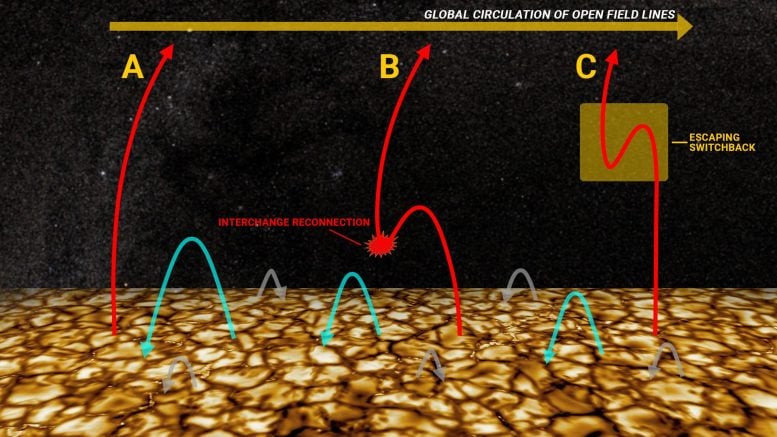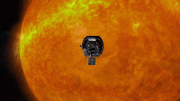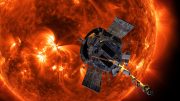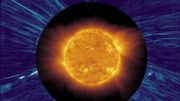
Realignment of open and closed magnetic field lines on the Sun, called interchange reconnection, could explain the magnetic “switchbacks” observed by Parker Solar Probe. Credit: Justin Kasper and Levi Hutmacher/University of Michigan Engineering
New analysis published April 29, 2020, in the Astrophysical Journal Letters provides a possible explanation for the origin of switchbacks — sudden reversals in the magnetic field of the solar wind — first observed by Parker Solar Probe during its November 2018 solar flyby. A new paper by scientists Justin Kasper and Lennard Fisk of the University of Michigan suggests the origin of switchbacks is related to the way the Sun maintains and moves magnetic field lines that stretch out into the solar system, tied to a theory first proposed more than two decades ago.
The Sun’s complex magnetic field is mostly made up of closed loops of magnetic field with both ends anchored in the Sun. The Sun’s less-common open field lines migrate between the Sun’s north and south poles over the course of the approximately 11-year solar cycle, during which the overall magnetic field reverses in polarity. A theory first published by Fisk and colleagues more than two decades ago explains the process behind this field line migration, and its predictions line up with the switchbacks observed by Parker Solar Probe.
The switchbacks —essentially S-shaped kinks in the magnetic field lines streaming from the Sun — seem to arise from a reconfiguration of open and looped magnetic field lines already in the Sun’s atmosphere. When an open magnetic field line encounters a closed magnetic loop they can undergo a process called interchange reconnection. This allows the open magnetic field line to snap into the loop, and allows one side of the formerly closed magnetic loop to connect to solar magnetic field extending outwards into the solar system. This process would create an outward-flowing S-shaped kink in the newly formed open magnetic field line — a shape that tracks with the switchbacks measured by Parker Solar Probe.
This interchange reconnection also drags the open magnetic field line across the solar surface, meaning that the Sun’s magnetic field can move east to west faster than solar rotation alone explains. This aligns with observations made during Parker Solar Probe’s first solar encounters: the larger than expected “sideways” motion of solar wind near the Sun. This, the authors suggest, is the expression of the plasma’s and magnetic field’s flow pattern deeper in the solar corona.
This theory, first proposed in 1996 based on data from the ESA/NASA Ulysses mission, could unify these two aspects Parker Solar Probe’s early observations. The mission’s future solar encounters, progressively closer to the Sun, will help scientists further investigate the switchbacks’ origins and test the predictions of this theory.
Reference: “Global Circulation of the Open Magnetic Flux of the Sun” by L. A. Fisk and J. C. Kasper, 29 April 2020, The Astrophysical Journal Letters.
DOI: 10.3847/2041-8213/ab8acd








Still got it backwards. Magnetic fields are created by electricity, proven and applied scientific fact. They don’t somehow exist independently of electricity, which is the thing driving all these processes. Get schooled here:
https://www.thunderbolts.info/wp/2020/04/22/donald-scott-electric-sun-the-mystery-of-hot-solar-wind-space-news/